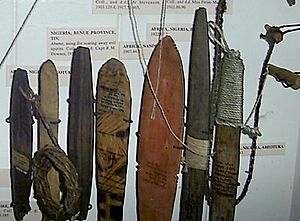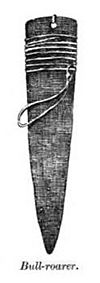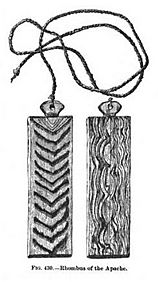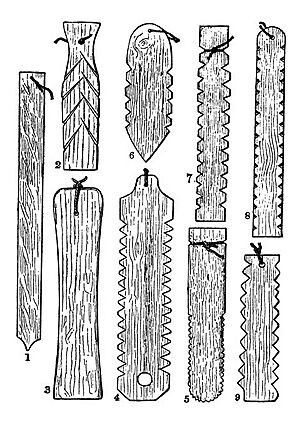Bullroarer facts for kids

A bullroarer is an ancient musical instrument and a tool used for sending messages over long distances. It's usually a flat piece of wood attached to a string. When you swing it around in a big circle, it makes a loud, roaring sound that vibrates.
This instrument is very old, dating back to the Paleolithic period (about 18,000 BC). Bullroarers have been found all over the world, including in Europe, Asia, Africa, the Americas, and Australia. In ancient Greece, it was a special instrument used in religious ceremonies. Today, it's still used in rituals in many parts of the world. For Aboriginal Australians, it was a very important tool for ceremonies and for communicating with other groups across the land.
Many cultures believe that the sounds made by a bullroarer can help ward off evil or bad influences.
Contents
How a Bullroarer Works and Sounds
A bullroarer is made from a thin, rectangular piece of wood. It's usually about 15 to 60 centimeters (6 to 24 inches) long and 1.2 to 5 centimeters (0.5 to 2 inches) wide. This wooden piece is shaped like an airfoil, which helps it spin. It's attached to a long cord. Sometimes, the edges of the wood are sharpened, or it might have small teeth-like cuts, depending on the culture that made it.
To use it, you first twist the cord a little. Then, you swing the bullroarer in a large circle. You can swing it flat (horizontally) or up and down (vertically). As it spins, the air makes it keep turning on its own axis. The cord winds up in one direction, then unwinds and winds up in the other, switching back and forth.
This spinning creates a special roaring sound that vibrates. The sound changes depending on how fast you swing it, how big the circle is, and how long the cord is. You can control the sound to make different patterns. This allows people to send coded messages.
The deep, low sound of the bullroarer can travel very far. On a quiet night, you can hear it clearly from many miles away.
Bullroarers in Different Cultures
For at least 19,000 years, many cultures have used bullroarers. They are used as musical instruments, for religious rituals, and for long-distance communication.
| North American Indian Bullroarers | ||
|---|---|---|
 |
 |
 |
| Navajo tsin ndi'ni "groaning stick" |
Apache tzi-ditindi "sounding wood" |
Gros Ventre nakaantan "making cold" |
While bullroarers have been used all over the world, they are perhaps best known for their use by Indigenous Australians. The name turndun comes from one of their languages.
Australian Aboriginal Culture
In Australian Aboriginal culture, bullroarers are used in initiation ceremonies and at burials. They are believed to scare away evil spirits or warn of bad news. For most Aboriginal groups, bullroarers are considered "secret men's business." This means that women, children, and uninitiated men are not allowed to hear them. The sounds are considered very sacred.
They are used in men's initiation ceremonies. In some cultures, the sound represents the Rainbow Serpent. In southeastern Australia, the sound of the bullroarer is thought to be the voice of Daramulum. A bullroarer can only be made if it comes from a tree that holds his spirit.
The bullroarer can also be used in Aboriginal art.
Ancient Greece
In Ancient Greece, bullroarers were especially used in ceremonies for the goddess Cybele. They were called a rhombos, which means "whirling" or "rumbling." This name described both its sound and its typical shape.
Britain and Ireland
In Britain and Ireland, bullroarers are mostly used for fun today. However, they might have been used for ceremonies in the past. In parts of Scotland, it was called a "thunder-spell." People believed it could protect them from lightning.
Stone Age cultures in Scandinavia also used bullroarers. In 1991, archaeologists found a 5000-year-old bullroarer made of slate in Norway.
Mali
The Dogon people in Mali use bullroarers to announce the start of special ceremonies. These ceremonies happen during the Sigui festival, which takes place every sixty years. The sound is believed to be the voice of an ancestor from whom all Dogon people are descended.
Māori Culture (New Zealand)
The pūrerehua is a traditional Māori bullroarer from New Zealand. Its name comes from the Māori word for moth. These instruments are made from wood, stone, or bone and are attached to a long string. They were traditionally used for healing or for making rain.
Native North American
Almost all native tribes in North America used bullroarers. They were used in religious and healing ceremonies, and sometimes as toys. There are many different styles.
For example, the Iñupiat people in North Alaska call them imigluktaaq or imigluktaun. They describe them as toy noise-makers made of bone or wood with braided sinew.
Native South American
Shamans in the Amazon basin, such as those in Tupi, Kamayurá, and Bororo cultures, used bullroarers as musical instruments for rituals. In Tupian languages, the bullroarer is known as hori hori.
See also
 In Spanish: Churinga para niños
In Spanish: Churinga para niños


